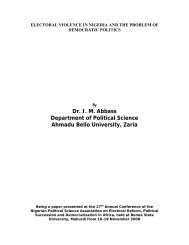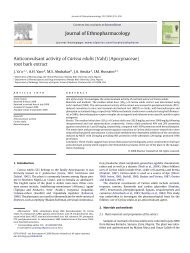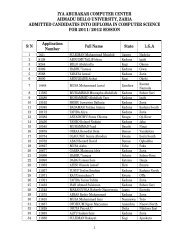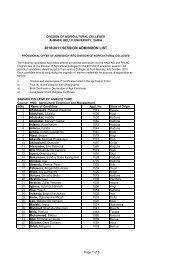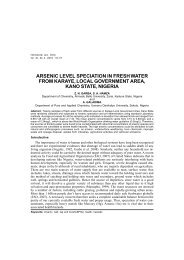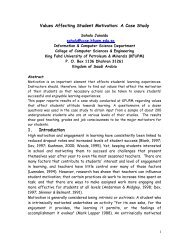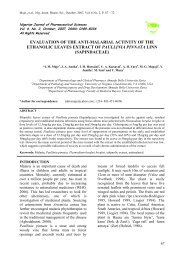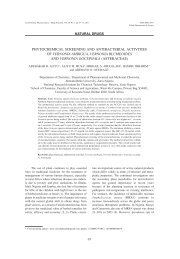Spectrophotometric analysis of Hibiscus sabdariffa colourant at ...
Spectrophotometric analysis of Hibiscus sabdariffa colourant at ...
Spectrophotometric analysis of Hibiscus sabdariffa colourant at ...
Create successful ePaper yourself
Turn your PDF publications into a flip-book with our unique Google optimized e-Paper software.
Olowosulu et al., Nig. Journ. Pharm. Sci., March, 2008, Vol. 7 No. 1, P. 36 – 40<br />
Nigerian Journal <strong>of</strong> Pharmaceutical Sciences<br />
Vol. 7, No. 1, March, 2008, ISSN: 0189-823X<br />
All Rights Reserved<br />
SPECTROPHOTOMETRIC ANALYSIS OF HIBISCUS SABDARIFFA<br />
COLOURANT AT DIFFERENT PH VALUES<br />
1 A. K. Olowosulu*, 2 P. A. Akpa, 2 U. V. Eze and 2 M. U. Adikwu<br />
1 Department <strong>of</strong> Pharmaceutics and Pharmaceutical Microbiology, Ahmadu Bello University, Zaria, Nigeria<br />
2 Department <strong>of</strong> Pharmaceutics, Faculty <strong>of</strong> Pharmaceutical Sciences, University <strong>of</strong> Nigeria, Nsukka, Nigeria<br />
*Author for Correspondence:<br />
08028440822, akolowo@yahoo.co.uk<br />
ABSTRACT<br />
<strong>Spectrophotometric</strong> analyses <strong>of</strong> the n<strong>at</strong>ural <strong>colourant</strong> from <strong>Hibiscus</strong> sabdarifa were carried out <strong>at</strong> different pH levels.<br />
The results show th<strong>at</strong> H. sabdarifa extract (<strong>colourant</strong>) was stable <strong>at</strong> the experimental pH range <strong>of</strong> 4.7 – 9.47. This was<br />
indic<strong>at</strong>ed by the similar peaks <strong>of</strong> absorption maxima <strong>at</strong> the different pH values. <strong>Hibiscus</strong> sabdarifa extract, with further<br />
studies could be used as a <strong>colourant</strong> in pharmaceutical formul<strong>at</strong>ions.<br />
Keywords: <strong>Spectrophotometric</strong> <strong>analysis</strong>, <strong>Hibiscus</strong> <strong>sabdariffa</strong>, <strong>colourant</strong>, pH effect<br />
INTRODUCTION<br />
The use <strong>of</strong> <strong>colourant</strong>s in cosmetics, foods and<br />
drugs d<strong>at</strong>es back to antiquity. Colours are so<br />
common in our environment th<strong>at</strong> we are not<br />
always aware just how much we depend on<br />
them. As <strong>colourant</strong>s abound, so are the<br />
reasons for using them. Colours could be used<br />
as a means <strong>of</strong> identific<strong>at</strong>ion, improvement <strong>of</strong><br />
aesthetics, and protection from various factors<br />
<strong>of</strong> degrad<strong>at</strong>ion, warning and concealment, to<br />
mention but a few (Marmion, 1984). The use<br />
<strong>of</strong> these <strong>colourant</strong>s, both n<strong>at</strong>ural and synthetic<br />
in foods, drugs and cosmetics went on<br />
unrestricted for quite some good number <strong>of</strong><br />
years. However, with the discovery <strong>of</strong> some<br />
fraudulent acts <strong>of</strong> marketing the same<br />
<strong>colourant</strong> under different names and also the<br />
discovery <strong>of</strong> some dangerous and undesirable<br />
properties <strong>of</strong> some <strong>colourant</strong>s, specific<strong>at</strong>ions<br />
and restrictions have been placed on the<br />
manufacture, sale and use <strong>of</strong> these <strong>colourant</strong>s<br />
in foods, drugs and cosmetics. Some<br />
<strong>colourant</strong>s were found to be carcinogenic,<br />
ter<strong>at</strong>ogenic, degrade to toxic metabolites and<br />
various unwanted products. Consequent upon<br />
these, <strong>colourant</strong>s used in foods, drugs and<br />
cosmetics were required to meet with the<br />
following specific<strong>at</strong>ions (Bainbridge, 1926).<br />
i) Arsenic contents must be less than<br />
1/700,000.<br />
ii) Must be free from heavy metals<br />
according to authorized test.<br />
iii) Must be structurally true to type.<br />
iv) The allowable amount <strong>of</strong><br />
contamin<strong>at</strong>ion with other dyes<br />
varies between 1.5% and 3%.<br />
36
Olowosulu et al., Nig. Journ. Pharm. Sci., March, 2008, Vol. 7 No. 1, P. 36 – 40<br />
v) Decomposed dyes and other<br />
organic impurities must be reduced<br />
to a minimum.<br />
vi)<br />
Insoluble m<strong>at</strong>ter must in no case<br />
exceed 0.3%.<br />
The carcinogenic effect is most common with<br />
synthetic <strong>colourant</strong>s. Thus the use <strong>of</strong> n<strong>at</strong>ural<br />
<strong>colourant</strong>s is most desirable. This study is<br />
geared towards the evalu<strong>at</strong>ion <strong>of</strong> a n<strong>at</strong>ural<br />
<strong>colourant</strong> from <strong>Hibiscus</strong> <strong>colourant</strong> for use in<br />
food and drugs. The emphasis on pH is to see<br />
the possibility <strong>of</strong> using it in different<br />
formul<strong>at</strong>ions <strong>of</strong> food, cosmetic and drug <strong>at</strong><br />
different pH levels. <strong>Hibiscus</strong> belongs to a<br />
family <strong>of</strong> plants called malvaceae <strong>of</strong> which<br />
over three hundred species have been<br />
described (Trease and Evans, 1995). A tea<br />
prepared from the dry calyxes and flower<br />
popularly called “Zobo drink” in Nigeria is<br />
widely consumed for its refreshing qualities.<br />
This is prepared by boiling the dried calyxes<br />
and flowers in some quantities <strong>of</strong> w<strong>at</strong>er for<br />
some time. The concentr<strong>at</strong>e is strained<br />
through a muslin cloth and allowed to cool.<br />
Flavours and sweeteners are added to taste<br />
and the product consumed best as a refreshing<br />
cold drink. <strong>Hibiscus</strong> (red calyxes) yields its<br />
colour easily to w<strong>at</strong>er. It is highly soluble in<br />
w<strong>at</strong>er th<strong>at</strong> it does not need gre<strong>at</strong> effort or<br />
special technique to get it into solution. It is<br />
used in colouring wines, ice – creams, butter,<br />
marmalade, refreshing beverages, pudding and<br />
cakes calyxes are used in the West Indies and<br />
elsewhere in the tropics to colour and flavour<br />
rum (Ndu, 2003). The effect <strong>of</strong> pH changes on<br />
the <strong>colourant</strong> is the main focus <strong>of</strong> this study.<br />
MATERIALS AND METHODS<br />
The following m<strong>at</strong>erials were used as<br />
procured without further purific<strong>at</strong>ion:<br />
hydrochloric acid and sodium chloride<br />
(Merck). Distilled w<strong>at</strong>er was obtained from an<br />
all glass still.<br />
Prepar<strong>at</strong>ion <strong>of</strong> <strong>Hibiscus</strong> Extract<br />
The hibiscus extract was prepared by soaking<br />
the calyxes in distilled w<strong>at</strong>er for about twentyfour<br />
hours. After extraction, the solution was<br />
filtered through a fine mesh muslin cloth to<br />
obtain a clear, deeply pink to dark red<br />
coloured solution. The solution was then<br />
concentr<strong>at</strong>ed by boiling <strong>of</strong>f some quantities <strong>of</strong><br />
the solvent. The dried m<strong>at</strong>erial was obtained<br />
by lyopholiz<strong>at</strong>ion. The m<strong>at</strong>erial obtained was<br />
stored in amber-coloured bottles to prevent<br />
darkening which <strong>of</strong>ten occurs when the<br />
m<strong>at</strong>erial is exposed to light.<br />
Absorption spectra <strong>of</strong> <strong>Hibiscus</strong> extract <strong>at</strong><br />
different pH values<br />
A 0.2-%w/v concentr<strong>at</strong>ion <strong>of</strong> the <strong>colourant</strong><br />
was made in aqueous solution and pH values<br />
adjusted to 4.7, 5.5, 7.0, 8.7 and 9.47<br />
respectively. These solutions were scanned in<br />
turn <strong>at</strong> intervals <strong>of</strong> 1 nm using UV – Vis<br />
spectrophotometer (Pye-Unicam, England).<br />
Their peak absorbances were all determined.<br />
Beer’s plot <strong>of</strong> <strong>Hibiscus</strong> <strong>colourant</strong> solution<br />
A stock solution <strong>of</strong> <strong>Hibiscus</strong> (zobo) <strong>colourant</strong><br />
(1% w/v) was made by dissolving 1 g <strong>of</strong> the<br />
solid extract in 100 ml <strong>of</strong> distilled w<strong>at</strong>er. A<br />
serial dilution <strong>of</strong> the stock was made to obtain<br />
concentr<strong>at</strong>ions <strong>of</strong> 1 mg/ml, 2mg/ml, 3mg/ml,<br />
4mg/ml and 5mg/ml. The maximum<br />
absorbances <strong>of</strong> these solutions were<br />
determined using the UV –VIS<br />
spectrophotometer <strong>at</strong> 580 nm (Pye-Unicam,<br />
England) and plotted against the concentr<strong>at</strong>ion<br />
to obtain a standard plot.<br />
RESULTS AND DISCUSSION<br />
A straight line passing through the origin was<br />
obtained for the Beer’s plot (Fig.6). This show<br />
th<strong>at</strong> light absorbance <strong>of</strong> standard solution <strong>of</strong><br />
hibiscus <strong>colourant</strong> extract can be used in<br />
quantit<strong>at</strong>ive <strong>analysis</strong> <strong>of</strong> the crude extract.<br />
Table 1 shows the absorption peaks <strong>of</strong> the<br />
hibiscus extract solution prepared <strong>at</strong> different<br />
pH values. <strong>Hibiscus</strong> <strong>colourant</strong> solution, within<br />
the limits <strong>of</strong> pH range chose, showed<br />
consistency in its wavelength <strong>of</strong> the peak <strong>of</strong><br />
37
Olowosulu et al., Nig. Journ. Pharm. Sci., March, 2008, Vol. 7 No. 1, P. 36 – 40<br />
absorption <strong>of</strong> light spectrum (Figs 1, 2, 3, 4<br />
and 5). This shows th<strong>at</strong> a single chromophore<br />
is contained in the hibiscus extract. Had it<br />
been composed <strong>of</strong> several chromophores, it<br />
would have shown different wavelengths <strong>of</strong><br />
peak absorption. Results also indic<strong>at</strong>e the<br />
stability <strong>of</strong> the <strong>colourant</strong> within the stipul<strong>at</strong>ed<br />
pH range. Different colours have their<br />
different and characteristic wavelength <strong>of</strong><br />
peak absorption. It was found th<strong>at</strong> hibiscus<br />
<strong>colourant</strong> extract was stable <strong>at</strong> the<br />
experimental pH-range <strong>of</strong> 4.7 – 9.47. The<br />
spectrophotometer <strong>analysis</strong> did not show<br />
significant instability as a result <strong>of</strong> the pH<br />
modific<strong>at</strong>ions. Due to the adverse effects <strong>of</strong><br />
some synthetic <strong>colourant</strong>s, which include<br />
carcinogenicity, tetr<strong>at</strong>ogenicity and various<br />
other toxic effects (Anstead, 1991), n<strong>at</strong>ural<br />
<strong>colourant</strong> such as Hibscus <strong>sabdariffa</strong> can be<br />
used. N<strong>at</strong>ural <strong>colourant</strong>s have wider margin <strong>of</strong><br />
safety than synthetic <strong>colourant</strong>s. In conclusion<br />
it can be st<strong>at</strong>ed th<strong>at</strong> <strong>Hibiscus</strong> <strong>sabdariffa</strong><br />
<strong>colourant</strong>, with further studies, could be used<br />
as a <strong>colourant</strong> in pharmaceutical formul<strong>at</strong>ions<br />
especially syrup.<br />
Table 1: Effect <strong>of</strong> pH on the peak absorption values<br />
pH values<br />
Peak Absorption (nm)<br />
4.7 520<br />
5.5 520<br />
7.0 520<br />
8.7 519<br />
9.47 520<br />
1.5<br />
1.2<br />
1<br />
Absorbance<br />
1<br />
0.5<br />
0<br />
0 500 1000<br />
Wavelength(nm)<br />
Absorbance<br />
0.8<br />
0.6<br />
0.4<br />
0.2<br />
0<br />
0 500 1000<br />
Fig.1 Sample scan <strong>of</strong> zobo extract<br />
in buffer<br />
(pH 4.7)<br />
Absorbance<br />
Wavelength<br />
Fig.2 Sample scan <strong>of</strong> zobo extract in<br />
buffer<br />
(pH Absorbance 5.5)<br />
38
Olowosulu et al., Nig. Journ. Pharm. Sci., March, 2008, Vol. 7 No. 1, P. 36 – 40<br />
1. 2<br />
1<br />
0.8<br />
0.6<br />
0.4<br />
0.2<br />
0<br />
0 200 400 600 800<br />
Wavel ength(nm)<br />
Absorbance<br />
1.2<br />
1<br />
0.8<br />
0.6<br />
0.4<br />
0.2<br />
0<br />
0 200 400 600 800<br />
Wavelength (nm)<br />
Fi g.3 Sampl e scan <strong>of</strong> Zobo extr act i n buf f er (pH 7.0)<br />
Fig.4 Sample scan <strong>of</strong> zobo extract in buffer<br />
(pH 8.7)<br />
Absor bance<br />
Absorbance<br />
2.5<br />
2<br />
Absorbance<br />
1.2<br />
1<br />
0.8<br />
0.6<br />
0.4<br />
0.2<br />
0<br />
0 200 400 600 800<br />
Absorbance<br />
1.5<br />
1<br />
0.5<br />
Wavelength(nm)<br />
0<br />
0 2 4 6 8<br />
Fig.5 Sample scan <strong>of</strong> zobo extract in buffer<br />
(pH 9.74)<br />
Abs orbance<br />
-0.5<br />
Concentr<strong>at</strong>ion (mg/ml)<br />
Beer's plot for Zobo extract in w<strong>at</strong>er<br />
Fig 6: Beer’s plot for H. <strong>sabdariffa</strong><br />
extract in w<strong>at</strong>er<br />
39
Olowosulu et al., Nig. Journ. Pharm. Sci., March, 2008, Vol. 7 No. 1, P. 36 – 40<br />
REFERENCES<br />
Anstead, D. F. (1991) Cosmetic colours. In: In.<br />
Handbook <strong>of</strong> Cosmetic Science, Pergamon Press, New<br />
York, Pp. 101-118.<br />
Bainbridge, W.C. (1926) Development <strong>of</strong> the food<br />
colour industry in the United St<strong>at</strong>es. Ind. Eng. Chem.<br />
USA, Pp.1329-1331.<br />
Marmion, D M. (1984) Handbook <strong>of</strong> U.S. Colourants<br />
for Foods, Drugs and Cosmetics 2 nd Ed., John Wiley<br />
and sons, U.S.A., P. 3.<br />
Ndu, O. (2003). M. Pharm. Thesis, University <strong>of</strong><br />
Nigeria, Nsukka.<br />
Trease, G.E. and Evans, W. C. (1995). A Textbook <strong>of</strong><br />
Pharmacognosy, W B Sauders. London, Pp. 201.<br />
40



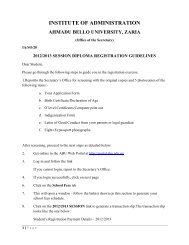
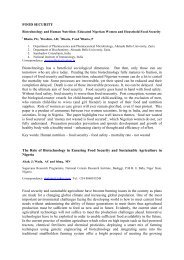

![Full Paper [PDF]](https://img.yumpu.com/49740055/1/184x260/full-paper-pdf.jpg?quality=85)
